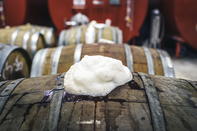Fermentation is the process during which micro-organisms convert starches (carbohydrates) and sugars into by-products such as alcohol (wines) and acids like lactic acid (cheese) and carbon dioxide (beer).

Fermentation as a controlled food processing tool is used to change the flavour of certain products (e.g. from grape juice to wine), preserving raw materials (e.g. cabbage made into sauerkraut and kimchi) and to create new foods (e.g. monosodium glutamate - MSG).
What is Fermentation?
Fermentation is the process during which the sugar (glucose) in a food or raw material is broken down by a variety of microbes. During the fermentation process, byproducts such as carbon dioxide, glycerol, acetone and alcohols are formed.
Fermentation can be catalysed by moulds, bacteria, yeasts or enzymes and the type of byproduct depends on which organism started the process. For example, monosodium glutamate (MSG) is formed when bacteria is involved, vitamins B2 and B12 from mould fermentation and alcohol and carbon dioxide is formed after yeast fermentation.
Fermentation happens in the absence of oxygen and is, therefore, an anaerobic process.
Types of Fermentation
Fermentations are classified according to the type of microorganism involved, the byproducts produced (e.g. ethanol, lactic acid, carbon dioxide) and the food being fermented - meats, fish, milk, vegetables, legumes such as soybeans, grains and fruits.
Three types of fermentation are briefly discussed:
One type of fermentation is lactic acid fermentation.
Starches or sugars are converted into lactic acid through the activity of yeasts and bacteria. During this type of fermentation, foods like yoghurt, sourdough bread, sauerkraut and kimchi are created. (Kimchi is a spicy traditional Korean dish made from fermented cabbage, red pepper powder, garlic, ginger etc. by impoverished populations).
Another type of fermentation is alcohol fermentation.
During alcoholic fermentation starches or sugars are converted into ethanol and carbon dioxide by yeasts. Examples of products are wine and beer.
A third type of fermentation is acetic acid fermentation.
Grains and fruit are fermented to form vinegars and kombucha, which is a fermented tea drink.
Benefits of Fermentation
Fermented products are often easier to digest than the original raw material and can accumulate other benefits such as immune-boosting enzymes, probiotics (‘live cultures’) and nutrients such as vitamin C, iron and zinc during the fermentation process.
Fermentation can also reduce or eliminate harmful substances such as the ‘anti-nutrient’ phytic acid. Phytic acid binds nutrients such as calcium, magnesium, zinc and iron in grains and beans. In the enzymatic processes during fermentation, phytic acid is broken down and these nutrients are released and become available for the body to absorb.
Fermented Products
Beer and wine are well-known fermented products made by the fermentation of sugars through yeast. In beer, the results of the fermentation is visible as ‘foam’ (or beer head) and in both beverages, alcohol provides an additional benefit.
Soy sauce and miso paste are made by fermenting soybeans, wheat grain, water and salt.
Monosodium glutamate (MSG) is produced by fermenting materials such as sugar beets, sugar cane or molasses.
Other fermented products include salami, olives, cheese, vinegar, tempeh (an Indonesian soy product) and natto (a sticky pungent Japanese food made from soybeans).
Not all fermented foods contain live cultures. Some foods are further processed and during processes like pasteurisation, baking or smoking, during which microbes will be killed. Examples are soy sauce, beer and wine as well as chocolate and sourdough bread.
Fermentation is also used during the production of tea, whisky, vodka etc.
By Marinda Louw